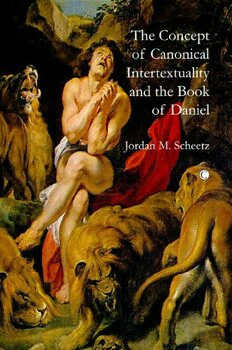
The Concept of Canonical Intertextuality and the Book of Daniel PDF
Preview The Concept of Canonical Intertextuality and the Book of Daniel
The Concept of Canonical Intertextuality and the Book of Daniel Jordan M. Scheetz C The Concept of Canonical Intertextuality and the Book of Daniel The Concept of Canonical Intertextuality and the Book of Daniel Jordan M. Scheetz C James Clarke & Co James Clarke & Co P.O. Box 60 Cambridge CB1 2NT United Kingdom www.jamesclarke.co [email protected] ISBN: 978 0 227 68020 9 British Library Cataloguing in Publication Data A record is available from the British Library First published by James Clarke & Co, 2012 Copyright © Jordan M. Scheetz, 2011 First Published, 2011 Published by arrangement with Pickwick Publications All rights reserved. No part of this edition may be reproduced, stored electronically or in any retrieval system, or transmitted in any form or by any means, electronic, mechanical, photocopying, recording, or otherwise, without prior written permission from the Publisher ([email protected]). Contents Preface • vii Abbreviations • ix 1 Intertextuality, Canon Criticism, and Biblical Studies • 1 2 Three Approaches to the Interpretation of Daniel • 36 3 Canonical Intertextuality: Daniel 1–6 • 48 4 Canonical Intertextuality: Daniel 7–12 • 85 5 Canonical Intertextuality and the Book of Daniel in the Old Testament • 129 6 Canonical Intertextuality and the Book of Daniel in the New Testament • 147 Bibliography • 161 Author Index • 165 Biblical and Ancient Text Index • 167 Preface This proposal for the concept of canonical intertextuality is an at- tempt to make sense of the complex issues one faces with the biblical text, which is at the same time a singular text and yet many texts. My presuppositions are orthodox and traditional in some ways. I believe that the text of Scripture is connected with historical realities where God has intervened in history. This revelation becomes the foundation from which texts are developed, collected, and ordered together. In turn this text, through the guidance of the Holy Spirit, is revelation. In other ways my research reflects a complexity in the development of the text that stands on the shoulders of both pre-critical and critical scholarship. Difficulties can be ignored or exaggerated, but my hope is to draw the debate in a more profitable direction where the biblical text’s voice and plurality of voices can be heard and understood without the need for either overly harmonistic solutions or confused fictions. All biblical quotes from the original languages have been taken from BibleWorks 5. I have chosen to use pointed texts from the Hebrew Bible to allow for easier reading due to the extensive usage and citations from these texts. However, I have retained the Masoretic Text instead of the Ketiv/Qere readings given in the BibleWorks 5 text (except in one place). All translations are my own and are intended to aid in the reading of the ancients texts quoted in Hebrew, Aramaic, and Greek, whether biblical or extra-biblical. Quotes from German have not been translated. All verse references in relation to the Hebrew Bible correspond to the Hebrew text numbering system which at times differs from English translations. I am very thankful for those who have read and commented extensively on the whole of the text: Prof. Dr. DDr. James Alfred Loader, David Sanford, and my wife, Rachel. My own canonical opinions have been influenced heavily by not only the writers cited in the following pages but by personal contact with three professors in particular. Prof. Dr. Ray Lubeck first introduced me and a vii viii Preface myriad of other students to the concept of an overarching logic operat- ing in particular within the Hebrew Bible. Prof. Dr. John Sailhamer not only opened my eyes to reading the biblical text by sight in the original languages, but thoroughly grounded me through hours of discussion in and outside the classroom in relation to the historical and exegetical argu- ments for a canonical perspective. Prof. Dr. DDr. James Alfred Loader has broadened and sharpened my perspective through hours of discussion and pages upon pages of interaction. I am thankful for their influence and devotion at different stages in my life. I have been shaped through their unique academic and Christian perspectives. My wife and children have endured the most through this entire process. Over the course of nearly five years, I have been away from the home literally months, and even while at home countless hours of re- search and writing have possessed me again and again. To my wife Rachel and my children Lela, Hannah, Joshua, Joel, and Jakob, I can only say a deep and sincere thank you. May my work on The Concept of Canonical Intertextuality and the Book of Daniel somehow benefit them and many others for years to come. Abbreviations AB Anchor Bible ABD The Anchor Bible Dictionary. 6 vols. Edited by David Noel Freedman. New York: Doubleday, 1992 ATD Das Alte Testament Deutsch BDB Francis Brown, S. R. Driver, and Charles A. Briggs. Hebrew and English Lexicon of the Old Testament. Oxford: Clarendon, 1907 BSac Bibliotheca Sacra BZAW Beihefte zur Zeitschrift für die alttestamentliche Wissenschaft CBQ Catholic Biblical Quarterly GKC W. Gesenius, E. Kautzsch, A. E. Cowley, Gesenius’ Hebrew Grammar HALOT L. Koehler, W. Buamgartner, and J. J. Stamm. The Hebrew and Aramaic Lexicon of the Old Testament. Translated and edited under the supervision of M. E. J. Richardson. 4 vols. Leiden, 1994–1999 HTS Harvard Theological Studies ICC International Critical Commentary Int Interpretation ISBE Geoffrey M. Bromiley, general editor. The International Standard Bible Encyclopedia. 4 vols. Rev. ed. Grand Rapids: Eerdmans, 1979–1988 NICNT New International Commentary on the New Testament NIGTC New International Greek Testament Commentary JBL Journal of Biblical Literature JSOT Journal for the Study of the Old Testament OTL Old Testament Library VT Vetus Testamentum VTS Vetus Testamentum Supplements ZAW Zeitschrift für die alttestamentliche Wissenschaft ix
